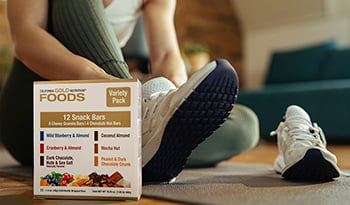Nutrition Reset—7 Important Nutrition Tips From a Dietician
DISCLAIMER:This blog does not intend to provide diagnosis...
- In this article:
- 1. Cut Your Sugar in Half
- 2. Load up on Fiber
- 3. Eat Protein at Every Meal
- 4. Choose Smaller Portions
- 5. Don’t Skip a Meal
- 6. Get a Water Bottle
- 7. Write It Down

You need an occasional tune-up in many areas of life to keep things running smoothly. You service your car regularly to avoid major issues. A periodic check-in with a massage therapist keeps you injury-free. And the same sort of tune-up can be done with your eating habits.
There is no single right way to approach nutrition. But a collection of positive habits that fit your lifestyle can help you progress toward your goals. Weight loss improved medical health and sports performance, and even better sleep are some outcomes you may notice when you dial in your nutrition habits.
If you want to improve your nutrition habits, you’ve come to the right place. Overhauling your entire approach to food can feel daunting, but rest easy knowing small changes can add up. No magic pill can improve the nutrition habits you’ve practiced for years, but with these suggestions, you can take manageable steps toward better eating.
Along with some of my favorite iHerb products, I’ve compiled a simple guide for dialing in your nutrition habits. Read on to learn how to make simple changes at home and the iHerb products that can make eating better a little easier.
1. Cut Your Sugar in Half
Added sugar can be found in a wide variety of foods—many of which you may not even realize contain sugar. While baked foods, soda, and candy are obvious sources of added sugar, sauces, dressings, condiments, and bread are lesser-known sources of sugar in the American diet.
Research suggests that added sugar may increase your risk of many health conditions. Weight gain, high blood pressure, fatty liver disease, and diabetes are some documented conditions associated with high sugar intake.1 Additionally, each of these conditions increases the risk of heart attack and stroke.1 For these reasons and more, monitoring the amount of added sugar you eat is essential.
The American Heart Association recommends no more than 150 calories of added sugar per day for men and 100 calories per day for women.2 If your current added sugar intake exceeds these guidelines, there are some simple ways to reduce the added sugar in your diet. Zero-calorie sweeteners, like stevia, monk fruit, and allulose, are great options that provide sweetness for few calories and no added sugar. Each of these can be used to sweeten beverages, like coffee or tea, and can also be used in baking and cooking.
You can also reduce your sugar intake by eating half of the sweetened items you are used to. If you eat two cookies each night, aim for just one. If you use two tablespoons of sugar in your coffee each morning, try cutting back to one.
2. Load up on Fiber
Fiber is a nutrient found in plant-based foods of all types. While fiber has many benefits, one of the most well-known is its ability to increase satiety. That means you’ll feel fuller after a fiber-packed meal and less likely to overeat and snack on lesser-quality food throughout the day.
Fiber supplements are available in capsule and gummy form that can easily be incorporated into your day. You can also add powdered forms to your favorite smoothie or a glass of water for a quick way to boost your intake.
Supplements are great in a pinch, but choosing fibrous foods is an even better solution. You can increase the fiber in your diet by eating more fruits, vegetables, whole grains, seeds, and legumes. Whole grains come in wide varieties, including oatmeal, quinoa, and crackers, just to name a few options. Dried fruit is another fiber-packed food that can easily be taken on the go for a quick snack or meal addition.
Beans and lentils are among the highest-fiber foods. They can be seamlessly incorporated into salads, soups, and side dishes for high-fiber meals. Lastly, nuts and seeds are a convenient source of fiber, as they can be eaten on the go or added to various meals and snacks for a no-prep fiber source.
3. Eat Protein at Every Meal
Like fiber, protein is another satiating nutrient that can curb overeating and excess snacking. Protein serves as a building block for muscle, bone, skin, and even blood, and some high-protein foods are also rich in important nutrients like iron and zinc.3
Breakfast, lunch, and dinner should all include a source of protein. Ideally, aim to incorporate protein into snacks as well. You may associate protein with prep work and time in the kitchen, but many convenient sources of this nutrient require little work to prepare.
Plant and animal-based foods contain protein, so protein sources are available no matter your dietary preferences. Nuts and seeds and nut butter are plant-based sources of protein that require zero preparation, can be incorporated into meals and snacks, and are perfect when you need something on the go.
Canned and pouched fish, including salmon and tuna, are another no-prep form of protein that can be enjoyed in a variety of ways. Combine with mashed avocado and serve over crackers or add directly to a bed of lettuce for easy meal inspiration.
If you like to eat breakfast on the run, protein powder blended with fruit is an easy, balanced option.
4. Choose Smaller Portions
When serving your meals, make sure your portions are appropriate. As a guideline, ensure your protein portion is about the size of your palm, your carb portion is no larger than the size of your fist, and your plate or bowl has at least one cup of fruits or veggies. Serving your meals on a smaller plate may help you stick to appropriate portions and visually help you feel more satisfied with a meal. If you are still hungry after finishing your meal, add another portion of vegetables and protein.
Individually portioned items are another way to help control your portion sizes. Single-serve portions of oatmeal for breakfast and dried fruit for snacks can limit overserving and keep calories appropriate. You can also create your single-serve packages at home with nuts and crackers by portioning individual servings into food storage containers.
5. Don’t Skip a Meal
When focused on completing your daily tasks, going too long without eating can be tempting. And while it may seem like skipping meals and snacks is a solution for weight loss, doing so can make it harder to achieve your goals. Eating appropriate portions of good-quality food throughout the day benefits your weight goals and ensures you get enough nutrients to support your body’s needs. To ensure you don’t skip meals, keep shelf-stable food handy for quick options.
A protein bar with fresh fruit, a serving of salmon or tuna with crackers and a handful of baby carrots, or an apple with nut butter and a piece of jerky on the side are just three quick meals that can be put together in a matter of seconds. Aim to eat within an hour of waking up and every three to four hours throughout the day, finishing your last food at least two hours before you head to bed.
6. Get a Water Bottle
You may be surprised to learn that hydration can impact your eating habits. When you are underhydrated, you may crave more starchy and salty foods that promote water storage in your body. You may notice fewer food cravings and increased satiety when you are well-hydrated.
Keeping a refillable water bottle on hand is an easy solution to help you drink more water. You can also count other non-caffeinated and zero-sugar drinks toward your total daily fluid intake. Herbal tea and sparkling water are excellent sources of hydration. You can even add flavor enhancers to your water to encourage higher consumption of liquids.
7. Write It Down
Keeping track of what you eat and drink daily may also benefit your overall nutrition habits. Whether you use an app to track your intake or keep a food diary on a piece of paper throughout the day, visual tracking may help you identify areas in which you excel or places in your diet that could improve. While detailed trackers that calculate calories and grams of nutrients can be helpful for some, others find this level of detail overwhelming.
The good news is any level of tracking, whether you’re just noting the food and portion or estimating every nutrient in each food, can enlighten you about your daily habits. This tracking can also reduce mindless eating and help you become more intentional with your daily food and drink choices.
References:
- The sweet danger of sugar - Harvard Health. Accessed March 6, 2023. https://www.health.harvard.edu/heart-health/the-sweet-danger-of-sugar
- Added Sugars | American Heart Association. Accessed March 6, 2023. https://www.heart.org/en/healthy-living/healthy-eating/eat-smart/sugar/added-sugars
- Protein Foods | MyPlate. Accessed March 6, 2023. https://www.myplate.gov/eat-healthy/protein-foods

 By Melissa Rifkin, MS, RDN, CDN
By Melissa Rifkin, MS, RDN, CDN


